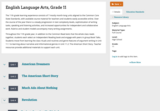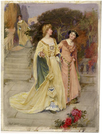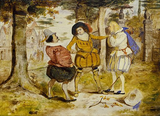
Learn basic keyboarding with this interactive keyboard. The focus is on identifying letter positions on the keyboard. Responses are checked immediately.
- Subject:
- Computer Science
- Technology
- Material Type:
- Game
- Provider:
- ABCya
- Date Added:
- 12/01/2023

Learn basic keyboarding with this interactive keyboard. The focus is on identifying letter positions on the keyboard. Responses are checked immediately.

This is the ninth article in a series that focuses on helping the new novel author. This article focuses on what the author calls "A, B, and C Characters," used to describe the different levels of characters.

Story Maps are used for teaching students to work with story structure for better comprehension. This technique uses visual representations to help students organize important elements of a story. Students learn to summarize the main ideas, characters, setting, and plot of an assigned reading.

Students cannot compare and contrast adventures and experiences in stories or explain differences between books without first understanding how to compare. In this lesson, students will learn how to use a Venn Diagram to compare two objects. Included is a printable template, and photos of the lesson.

In this lesson, students will compare and contrast characters within the story "Don't Need Friends" by Carolyn Crimi.

Links to 22 lessons that focus on skills within third grade reading standard RL.3.5: Distinguish their own point of view from that of the narrator or those of the characters.

This landing page offers a variety of lesson plans that instruct students on RL.K.2 With prompting and support, retell familiar stories, etc.

This landing page provides different lesson plan choices on teaching RL.K.3 With prompting and support, identify characters, settings,

Written by Master Teachers, BetterLesson provides lesson plans for all core subjects. This site provides 15 lessons for RL.K.9: With prompting and support, compare and contrast the adventures and experiences of characters in familiar stories.

Links to 2 lessons and activities that build student skills in standard W.3.3.b: Write Narratives to develop real or imagined experiences or events using effective technique, descriptive details, and clear event sequences.

This is a fun idea to display your students' book reports, and encourage reading at the same time! In this online lesson, children use special markers to actually draw their book report on the windows of the library or classroom. Also provides resources and adaptations. (To access this lesson plan, you must register with Crayola.com. Registration is free and takes only a few moments to complete.)

This is the seventh installment of a series giving advice to the author who is new to writing novels. This article focuses on how to take your characters and use them and their conflicts to develop the plot of your story. W.9-10.3b Narrative techn, W.11-12.3b Narratives

This site is a personal site from Caro Clarke. The third installment in this series looks at the four major mistakes made by beginning authors. The main idea of this article is that the author needs to be able to combine dialogue with action and know when and eliminating useless information.

This video, effective for engaging students with significant cognitive disabilities, demonstrates students ability to determine the significant events in the story and the way those events influence characters' feelings and actions.

This is the tenth in a series of articles designed to help the new novel author. This article focuses on how to develop characters through their actions instead of simply relying on dialogue and description of thoughts. W.11-12.3d Sensory/precise lang narratives, W.9-10.3b Narrative techn

Although Disney's version of Cinderella is most popular in America, hundreds of versions exist across many cultures. This resource provides lessons, which examine the similarities and differences in literary elements among many versions of this fairy tale.

The 11th grade learning experience consists of 7 mostly month-long units aligned to the Common Core State Standards, with available course material for teachers and students easily accessible online. Over the course of the year there is a steady progression in text complexity levels, sophistication of writing tasks, speaking and listening activities, and increased opportunities for independent and collaborative work. Rubrics and student models accompany many writing assignments.Throughout the 11th grade year, in addition to the Common Read texts that the whole class reads together, students each select an Independent Reading book and engage with peers in group Book Talks. Students move from learning the class rituals and routines and genre features of argument writing in Unit 11.1 to learning about narrative and informational genres in Unit 11.2: The American Short Story. Teacher resources provide additional materials to support each unit.

This unit uses William Shakespeare’s Much Ado About Nothing as a vehicle to help students consider how a person is powerless in the face of rumor and how reputations can alter lives, both for good and for ill. They will consider comedy and what makes us laugh. They will see how the standards of beauty and societal views toward women have changed since the Elizabethan Age and reflect on reasons for those changes. As students consider the play, they will write on the passages that inspire and plague them and on topics relating to one of the themes in the play. Finally, they will bring Shakespeare’s words to life in individual performances and in group scene presentations.
ACCOMPLISHMENTS
Students read Shakespeare’s Much Ado About Nothing .
Students read two Shakespearean sonnets and excerpts from an Elizabethan morality handbook dealing with types of women, and they respond to them from several different perspectives.
For each work of literature, students do some writing. They learn to write a sonnet; create a Prompt Book; complete a Dialectical Journal; and write an analytical essay about a topic relating to a theme in the play.
Students see Shakespeare’s play as it was intended to be seen: in a performance. They memorize 15 or more lines from the play and perform them for the class. Students take part in a short scene as either a director or an actor.
GUIDING QUESTIONS
These questions are a guide to stimulate thinking, discussion, and writing on the themes and ideas in the unit. For complete and thoughtful answers and for meaningful discussions, students must use evidence based on careful reading of the texts.
What are society’s expectations with regard to gender roles?
Does humor transcend time? Do we share the same sense of humor as our ancestors?
How do we judge people?
How important is reputation?
BENCHMARK ASSESSMENT (Cold Read)
During this unit, on a day of your choosing, we recommend you administer a Cold Read to assess students’ reading comprehension. For this assessment, students read a text they have never seen before and then respond to multiple-choice and constructed-response questions. The assessment is not included in this course materials.
CLASSROOM FILMS
The Branagh version of Much Ado About Nothing is available on DVD through Netflix and for streaming through Amazon. Other versions are also available on both sites.

In this lesson, students will come to see how the concept of deception can be looked at in more than one way and how this factors into Much Ado About Nothing ’s character development.

In this lesson, students will continue reading Much Ado About Nothing aloud and then compare and contrast the directorial choices made in two staged versions of act 2, scene 3.